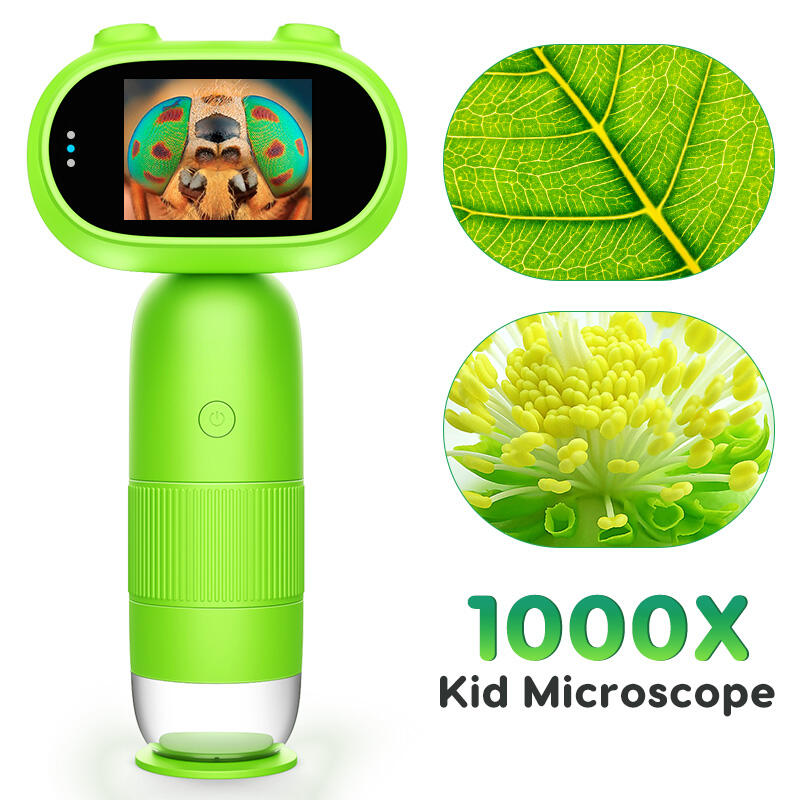Modern scientific exploration has been revolutionized by the development of advanced digital microscopy technology. A portable microscope represents a significant breakthrough in making detailed observation accessible to professionals, educators, and enthusiasts alike. These compact devices combine traditional optical excellence with cutting-edge digital capabilities, enabling users to capture, analyze, and share microscopic discoveries with unprecedented ease and convenience.

The integration of digital technology into portable microscopy has transformed how we approach specimen examination and documentation. Contemporary models offer remarkable magnification capabilities while maintaining portability that traditional laboratory microscopes simply cannot match. This technological evolution has opened new possibilities for field research, educational applications, and quality control processes across various industries.
Essential Digital Features for Modern Portable Microscopes
High-Resolution Display Technology
The display system serves as the primary interface between the user and the microscopic world. Modern portable microscope units incorporate high-definition screens that deliver crisp, clear images with exceptional color accuracy. These displays typically feature IPS technology, ensuring consistent viewing angles and superior image quality regardless of the user's position relative to the device.
Screen size considerations play a crucial role in user experience and practical application. Larger displays provide enhanced detail visibility, making it easier to identify specific structures and characteristics within specimens. The optimal screen dimensions balance portability requirements with visual clarity, ensuring that users can conduct detailed examinations without compromising device mobility.
Brightness and contrast adjustability features enable optimal viewing under various lighting conditions. These controls allow users to fine-tune display settings based on specimen characteristics and environmental factors, ensuring consistent image quality across different observation scenarios.
Advanced Magnification Capabilities
Magnification range represents one of the most critical specifications for any portable microscope system. Professional-grade devices typically offer magnification levels ranging from 50x to 1000x or higher, providing versatility for examining diverse specimen types. This broad magnification spectrum accommodates everything from basic surface inspection to detailed cellular structure analysis.
Digital zoom functionality complements optical magnification by providing additional enlargement capabilities without sacrificing image quality. Advanced interpolation algorithms ensure that digitally enhanced images maintain clarity and detail integrity even at maximum zoom levels. This feature proves particularly valuable when examining minute specimen features that require extreme magnification.
Smooth magnification transitions enable seamless switching between different zoom levels during observation sessions. This capability allows users to quickly adjust magnification settings without losing track of specific specimen areas, enhancing overall examination efficiency and user experience.
Image Capture and Documentation Systems
Photography and Video Recording
Contemporary portable microscope models incorporate sophisticated image capture systems that rival dedicated digital cameras. High-resolution sensors capture detailed still images and smooth video recordings, enabling comprehensive specimen documentation for research, education, or quality assurance purposes. These systems typically support multiple file formats and compression levels to accommodate various storage and sharing requirements.
Video recording capabilities prove essential for documenting dynamic processes and specimen behaviors. Time-lapse functionality allows users to capture slow changes over extended periods, while standard video recording preserves real-time observations for later analysis or presentation purposes.
Image stabilization technology ensures sharp, clear captures even when working with handheld devices. Advanced stabilization algorithms compensate for minor movements and vibrations, producing professional-quality images and videos suitable for scientific documentation and educational materials.
Storage and Connectivity Options
Internal storage capacity determines how many images and videos can be saved directly on the device. Modern portable microscope systems typically include substantial internal memory supplemented by expandable storage options through microSD cards or similar removable media. This flexibility ensures users never miss important observations due to storage limitations.
Wireless connectivity features enable seamless data transfer and remote viewing capabilities. Wi-Fi connectivity allows users to stream live images to smartphones, tablets, or computers, facilitating collaborative observation sessions and remote consultations. Bluetooth connectivity provides additional options for connecting external devices and accessories.
USB connectivity ensures compatibility with various computer systems and enables direct data transfer without requiring additional software or wireless networks. This universal connectivity approach guarantees that captured images and videos can be easily accessed and shared regardless of the available technology infrastructure.
Power Management and Battery Performance
Battery Life Optimization
Extended battery life represents a fundamental requirement for truly portable microscopy applications. Modern devices incorporate efficient power management systems that maximize operational time while maintaining consistent performance throughout the battery cycle. Advanced lithium-ion batteries provide reliable power delivery and extended service life under various operating conditions.
Power-saving modes automatically adjust device settings to conserve battery life during periods of inactivity or reduced functionality requirements. These intelligent systems monitor usage patterns and optimize power consumption without compromising essential features or image quality. Users can typically expect several hours of continuous operation from a single battery charge.
Rapid charging capabilities minimize downtime between observation sessions. Quick-charge technology enables devices to reach operational capacity within short charging periods, ensuring that portable microscope units remain available when needed most. Some models support charging during operation, providing uninterrupted service for extended examination sessions.
Power Source Flexibility
Multiple power source options enhance device versatility and ensure operation in various environments. Battery-powered operation provides complete portability, while AC adapter connectivity enables extended laboratory use without battery limitations. Some models also support power bank connectivity, extending field operation capabilities significantly.
Power consumption monitoring helps users plan observation sessions and manage battery resources effectively. Digital displays typically include battery level indicators and estimated remaining operation time, allowing users to make informed decisions about power management and charging requirements.
Energy-efficient LED illumination systems minimize power consumption while providing consistent, high-quality specimen lighting. These advanced lighting systems consume significantly less power than traditional halogen bulbs while offering superior color rendering and longer service life.
Illumination and Optical Enhancement
LED Lighting Systems
Professional-grade LED illumination systems provide consistent, adjustable lighting that enhances specimen visibility and image quality. These energy-efficient lighting solutions offer precise brightness control and color temperature adjustment, enabling optimal illumination for different specimen types and observation requirements. LED systems also generate minimal heat, preventing specimen damage during extended examination periods.
Multiple lighting modes accommodate various specimen characteristics and examination techniques. Incident lighting proves ideal for opaque specimens and surface examination, while transmitted lighting excels for transparent or translucent materials. Some advanced models incorporate both lighting types, providing maximum flexibility for diverse observation scenarios.
Color temperature adjustment capabilities ensure accurate color representation across different specimen types. This feature proves particularly important for biological specimens where natural coloration provides critical identification and diagnostic information. Users can fine-tune lighting characteristics to match specific observation requirements and personal preferences.
Optical Quality and Lens Technology
High-quality optical components form the foundation of superior image quality in any portable microscope system. Premium glass lenses with advanced coatings minimize optical aberrations and maximize light transmission, ensuring sharp, clear images across the entire magnification range. Multi-element lens designs provide superior edge-to-edge sharpness and reduced distortion.
Anti-reflective coatings on optical surfaces reduce glare and improve image contrast, particularly important when working with highly reflective specimens or under bright lighting conditions. These specialized coatings also protect lens surfaces from environmental contaminants and extend optical component service life.
Parfocal lens systems maintain focus across different magnification levels, eliminating the need for constant refocusing when switching between zoom settings. This feature significantly improves examination efficiency and reduces the risk of losing track of specific specimen areas during observation sessions.
User Interface and Control Systems
Intuitive Operation Controls
User-friendly control interfaces ensure that portable microscope systems remain accessible to users with varying technical expertise levels. Touch-screen controls provide intuitive operation with responsive feedback, while physical buttons offer reliable operation in challenging environments. The combination of both control types accommodates different user preferences and operational requirements.
Menu systems organize device functions logically, enabling quick access to frequently used features while keeping advanced options readily available when needed. Customizable control layouts allow users to optimize interface configurations based on specific application requirements and personal workflow preferences.
Voice control capabilities in some advanced models enable hands-free operation during critical observation periods. This feature proves particularly valuable when users need to maintain precise specimen positioning while adjusting device settings or capturing images and videos.
Software Integration and Compatibility
Comprehensive software packages enhance device functionality and provide advanced image processing capabilities. These applications typically include measurement tools, annotation features, and image enhancement filters that transform basic observations into detailed scientific documentation. Cross-platform compatibility ensures software accessibility across different operating systems and device types.
Real-time image processing capabilities enable immediate enhancement and analysis of captured specimens. Advanced algorithms can highlight specific features, adjust contrast and brightness, and apply specialized filters to reveal hidden details or improve overall image quality for specific applications.
Cloud integration features facilitate easy sharing and collaboration among team members or educational groups. Secure cloud storage options ensure that important observations and documentation remain accessible from multiple devices while maintaining data security and privacy protection.
FAQ
What magnification level is most suitable for general purpose portable microscope applications
For general purpose applications, magnification levels between 100x and 400x provide optimal versatility for examining various specimen types. This range accommodates most educational, hobby, and basic professional requirements while maintaining good image quality and ease of use. Higher magnifications may be necessary for specialized applications requiring detailed cellular or structural analysis.
How important is battery life when selecting a portable microscope for field work
Battery life represents a critical factor for field work applications where access to charging facilities may be limited. Look for devices offering at least 4-6 hours of continuous operation, with power-saving modes that can extend usage time significantly. Consider models that support external power banks or multiple battery options for extended field sessions.
Can portable microscopes match the image quality of traditional laboratory microscopes
Modern high-end portable microscope systems can achieve image quality comparable to traditional laboratory microscopes for many applications. While they may not match the absolute optical performance of premium laboratory instruments, portable models offer sufficient quality for most educational, industrial, and research applications while providing unmatched convenience and flexibility.
What storage and connectivity features should I prioritize in a portable microscope
Prioritize devices with adequate internal storage supplemented by expandable memory options. Wi-Fi connectivity enables easy sharing and remote viewing, while USB connectivity ensures compatibility with various computer systems. Consider models with cloud integration capabilities if collaborative work or remote access to captured images is important for your applications.
Table of Contents
- Essential Digital Features for Modern Portable Microscopes
- Image Capture and Documentation Systems
- Power Management and Battery Performance
- Illumination and Optical Enhancement
- User Interface and Control Systems
-
FAQ
- What magnification level is most suitable for general purpose portable microscope applications
- How important is battery life when selecting a portable microscope for field work
- Can portable microscopes match the image quality of traditional laboratory microscopes
- What storage and connectivity features should I prioritize in a portable microscope

